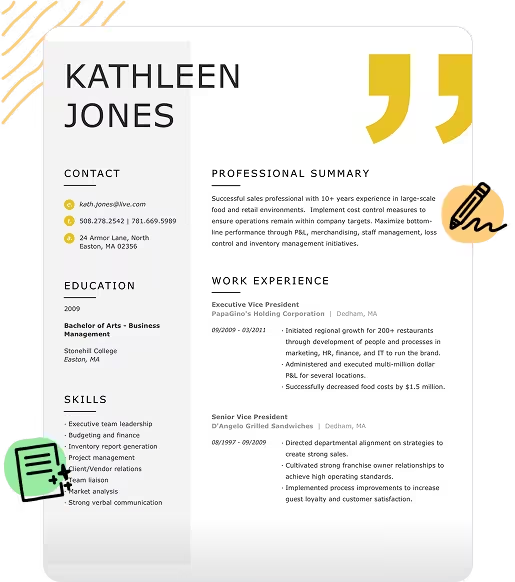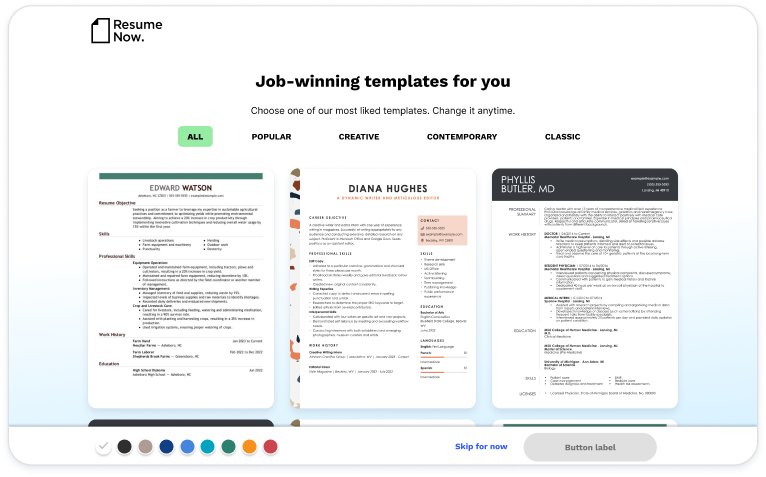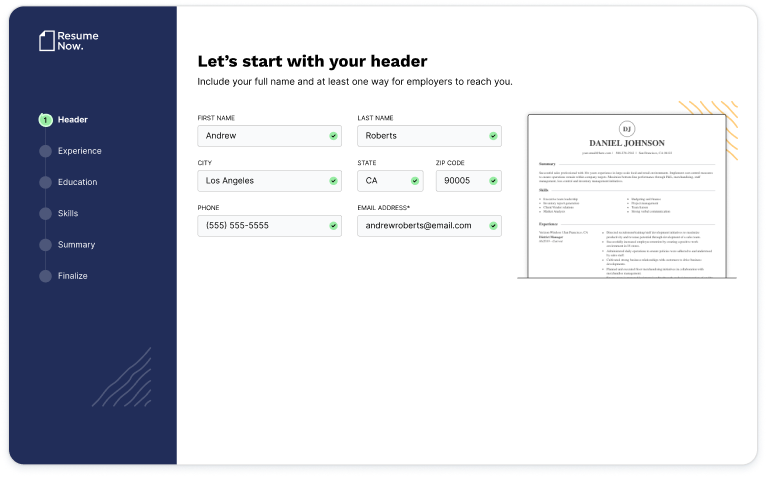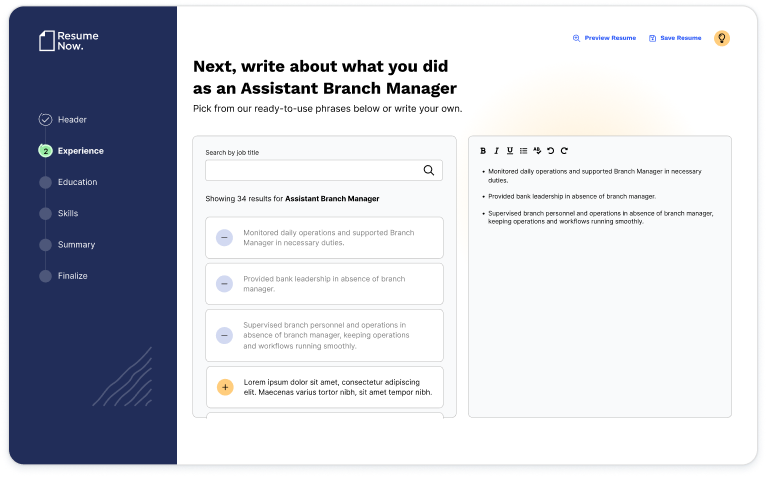Table of contents
- What Is a CV?
- How to Write a CV in 7 Easy Steps
- Choose a CV Template
- Add Your Contact Information
- CV Summary Statement Examples by Industry
- List Your Relevant Work Experience
- Add Relevant Skills for the Role
- Build Your CV Education Section
- Include Additional CV Sections
- Great CV Examples
- 5 Tips for Writing a Standout CV
- 5 Common CV Mistakes to Avoid
- CV Writing: Final Checklist
- How to Write a CV Using Our Builder
- Pair Your CV With a Cover Letter
- FAQ About How to Write a CV
A resume isn't right for everyone. If you're pursuing a career in research, medicine, law or academia, you may instead need to submit a curriculum vitae (CV) for your next job application. If that's the case, the first step in your job hunt is learning how to write a CV.
In this article, you'll learn what a CV is and how it differs from a resume. Additionally, this comprehensive guide will show you how to:
- Choose a CV template.
- Add your contact information.
- Write your CV's summary statement.
- List your relevant work experience.
- Craft your education section.
- Add relevant skills for the role.
- Include additional CV sections.

Want to make your CV quickly? Our CV Maker can help. It generates text based on your career details and automatically formats your sections for a polished and professional document you can submit today.
What Is a CV?
First things first — let's start by answering the most common questions: what is a CV and what are the differences between a CV vs resume?
The main difference is the context it is used in and its length. It's also important to note that the word "CV" has different meanings depending on where you live. In Europe, a CV is the same as a resume, just with a different name. In the United States, a CV and a resume are different documents.
An American CV is used in highly specialized fields that require more information than a resume covers in its one page. This makes a CV longer and more detailed than a resume — usually two pages or longer.
So, do you need to write a CV or a resume for the job you're applying to? How do you know? It's simple: For most jobs in the U.S. and in Europe, you should write a resume — just remember to call it a "CV" if you're applying in Europe.
However, for certain professional fields in the U.S., like law, medicine and academia, applicants should write an American CV. For those fields, you'll need to learn how to write a CV that showcases your qualifications.
Need a resume instead? Learn how to write a resume using our comprehensive guide.
The 6 basic CV sections
How to Write a CV in 7 Easy Steps
You're here because you're wondering how to write a CV for a job application.
When you follow these simple instructions, writing a CV is easy. We've outlined seven steps to show you how to write a curriculum vitae you can be proud of.
Choose a CV Template
When you pick a CV template, you decide how your CV should be styled and organized. There are thousands of CV designs representing most career paths.
Whether you're buttoned-down and professional or creative and fashionable, there are templates well-suited to your career. Here are three template types we offer:
- Creative templates: Great for showing off your personality in a field like graphic design, architecture or photography.
- Modern templates: An excellent choice for emphasizing your credentials in various industries.
- Simple templates: A bare-bones approach ideal for industries like construction and logistics.
Here are three designs from our template library that show stylistic diversity. Each one helps your CV-writing pop differently:
All of our templates can be used with Microsoft Word and Google Docs and have been tested to ensure they will pass through an applicant tracking system (ATS), which is critical to landing an interview.
Add Your Contact Information
Your contact info should always be in the header at the top of the CV — either at the left, right or center. The exact location depends on your CV template. Your header should include your:
- First and last name.
- City and state.
- Phone number.
- Email address.
Feel free to include your LinkedIn profile, a portfolio site or professional social media handles if you have any.
Here are a few things you should never include in a CV header:
- Zodiac sign.
- Date of birth.
- Unprofessional email address.
It's important that your CV header only includes contact information, and that all of it is professional and easy to read.
CV headers come in a variety of styles. Below, we have provided two different header styles to show you how the header on your CV might look.
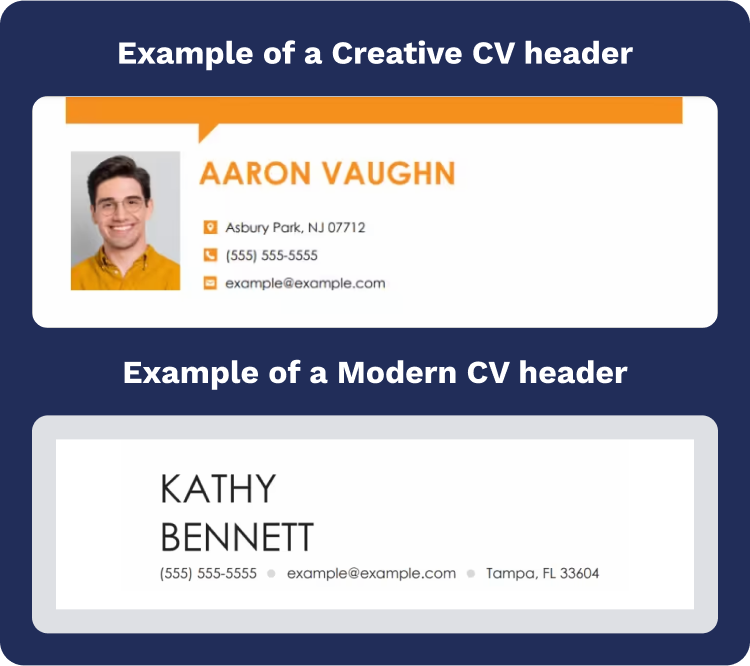
CV Summary Statement Examples by Industry
Think of the summary statement of your CV as your sales pitch. It should be concise but interesting enough to grab the reader's attention.
Excellent summaries, whether professional summaries or objective statements, communicate a candidate's core qualifications in a few sentences. They are focused, brief and full of critical keywords that show how well-suited you are to the role. Don't forget to use engaging language with action words to keep the recruiter engaged.
If you're unsure of which words to use, use the job listing as your guide. In the duties and requirements section of the job ad, you'll find a description of the role. Highlight any skills that pop out at you. You should include these keywords in your summary statement, also known as a resume profile. Just make sure the skills accurately represent your experience.
Here are a few well-written CV summary examples to help you write your own.
Lawyer summary statement example
Dedicated and results-driven attorney with 11 years of experience in intellectual property law. Adept at providing strategic legal advice and representation to clients while ensuring compliance with relevant laws and regulations. Proven track record of successfully managing complex legal matters from inception to resolution.
Nursing assistant summary statement example
Energetic healthcare professional dedicated to providing top-quality, patient-centered care. Highly skilled at addressing acute and chronic conditions. Resourceful navigation of complex healthcare environments to optimize patient well-being. Seeking a nursing assistant role at Milner Clinic.
College professor summary statement example
Passionate and accomplished mathematics professor with a proven track record of fostering an engaging learning environment and facilitating student success. Bringing 15 years of experience in instilling a love for mathematics and cultivating critical thinking skills. Adept at developing and delivering innovative curricula and committed to creating a positive and inclusive educational experience.
List Your Relevant Work Experience
Work experience is the focus of most CVs because hiring managers want to know that you have the required experience to perform the role. But this section shouldn't just be a list of job duties.
Including data and metrics helps show the results of your work. Prove to the employer that you're capable of achieving results and they'll want to see what you can do for their organization.
Before you write your CV, take an honest inventory of your job history. Write down your accomplishments and as many quantifiable achievements as you can. "X number of sales made" or "X number of customers served," for example.
Let's see what a perfect CV work history section looks like for roles in three industries.
Teaching assistant experience example
Teaching Assistant | 01/2021 to 12/2024
Purchase College, SUNY – Purchase, NY
- Collaborated with lead instructors in the History department to facilitate an interactive and inclusive learning environment for 126 undergraduate History majors.
- Assisted in the development and implementation of lesson plans, instructional materials and classroom activities.
- Provided individualized support to 10-20 students during office hours, addressing questions, clarifying concepts and offering guidance on assignments.
- Graded hundreds of assignments, exams and other assessments with attention to detail, ensuring accuracy and consistency in evaluation.
- Utilized educational technology tools to enhance student's learning experience and support remote learning initiatives.
Key achievements: Provided personalized assistance to students struggling with historical concepts, resulting in improved comprehension and grades for those students. Implemented creative strategies to increase student participation and interest in history, leading to a noticeable improvement in classroom engagement and academic performance.
Work experience sample for a civil engineer
Civil Engineer | 01/2019 – Present
Moody Engineering LLC
Elmhurst, NY
- Play a key role in the design and planning phase of the Main Street Bridge project, contributing to the development of detailed plans, specifications and engineering drawings. Attend meetings and site locations to gather data for project work.
- Respond to emergency sewer requests on a 24-hour basis and determine the most cost-effective repair method.
- Evaluate more than 300 sites per year as part of a collaborative team, including a biologist and a demographics expert.
- Successfully managed and executed projects from initiation to completion, ensuring adherence to project scope, budget and timeline.
Key achievements: Managed project budgets ranging from $5M to $15M, ensuring financial discipline and accountability throughout the project life cycle. Integrated sustainable and eco-friendly practices into projects, achieving a 7% reduction in environmental impact and promoting environmentally responsible engineering solutions.
Work experience example for a journalist
Senior Journalist | 09/2020 to 06/2024
Tallahassee Tribune – Tallahassee, FL
- Spearheaded investigative reporting, producing five in-depth articles on the police beat.
- Led a team of 10 reporters, providing editorial guidance, assigning stories and ensuring adherence to tight deadlines while maintaining the highest standards of journalistic integrity.
- Cultivated and maintained relationships with key sources, experts and community leaders to stay abreast of emerging trends, breaking news and exclusive story opportunities.
- Collaborated with the editorial team to develop and execute content strategies, contributing to the publication's editorial direction and maintaining a strong online and print presence.
Key achievements: Received the Society of Professional Journalism award for an investigative piece on police corruption, showcasing a deep understanding of the subject matter and excellence in journalism. Utilized data journalism techniques to present complex crime statistics in a clear and accessible manner, enhancing public understanding of law enforcement challenges.
Add Relevant Skills for the Role
Adding skills to your CV is an important, often overlooked part of a well-written CV. They show an employer you have both the technical and personal skills to do the job.
While this section doesn't involve much writing, it requires thoughtful preparation. You need a mix of hard and soft skills. We always suggest reading the job description closely to see what skills the employer is looking for. Highlight the skills that apply to you, then find a way to work them into your CV.
- Payroll software proficiency
- Tax compliance
- Mathematical aptitude
- Attention to detail
- Time management
- Data entry
- Recordkeeping
- Regulatory knowledge
- Administrative support
- Time management
- Problem-solving
- Calendar management
- Communication
- Discretion
- Travel Coordination
- Event Planning
Build Your CV Education Section
Your education section may not involve much actual writing but it's critical to your CV's success. For this section, focus intently on the formatting.
Whether you're learning how to write a CV for grad school, high school or anything in between, there are only a couple of rules:
- Keep your entries uniform.
- Only list high school if it's your highest level of education.
- Only add graduation dates to your CV if you're a very recent graduate.
Check out these examples for how the education section should look for different levels of education.
College graduate
Bachelor of Arts, Journalism
College of Communication & Information
Tallahassee, FL
Graduated in 06/2024
College, grad school + PhD
Ph.D.
Biochemistry and Molecular Biology, Michigan State
University, East Lansing, MI
Master of Science
Chemistry, University of Michigan – Ann Arbor
Ann Arbor, MI
Bachelor of Science
Biology, University of Michigan – Ann Arbor
Ann Arbor, MI
Include Additional CV Sections
There are more than a dozen sections you can add to your CV that might help you stand out. Here are some common additions:
- Certifications: Professional certificates you've earned through classes or tests.
- Awards: Notable awards or honors you've received for outstanding work, including grants and scholarships.
- Languages: Any languages you know, including your fluency level (e.g., novice, intermediate, expert).
- Publications: Relevant articles you've written that have been published in a journal, online publication or book.
- Hobbies and interests: Subjects of knowledge and enthusiasm related to your work.
- Conference attendance: Any relevant conferences and sessions you've attended.
- Membership affiliations: Being a member of a relevant club or professional association.
- Projects: Special relevant projects you've completed, whether for a course, a job or for personal reasons.
- Licenses: When you need a license to practice your profession.
- Teaching experience: If you must demonstrate you have taught before, make a special section for it.
Here's how a special section might look on a CV:
Certifications & Licenses:
- American Board of Pediatrics (ABP) certification
- Pediatric Advanced Life Support (PALS) certification
- California State Medical License
Great CV Examples
If you're still wondering how to write a CV, examples are a great resource. Not only do they show you how to write a CV, they can also inspire you.
First, let's review a CV example for a job application. The example below is for a standard CV you'd submit for a typical job.
CV example for a job application
Now, if you're wondering how to write a CV for grad school, that's a totally different matter. Grad school CVs are two or more pages long and include a more extensive history of the candidate's academic and professional achievements.
These CVs are more geared toward landing a job in an academic field like medicine or law. Optional sections include teaching experience, publications and conferences attended. Check out a visual example below.
CV example for grad school
5 Tips for Writing a Standout CV
Before you finish writing your CV and send it out into the world, there are a few things you should keep in mind. As you craft your document, review the following tips to cover all the critical parts of a CV:
- Customize your CV for every job
Hiring managers like applicants who research the company and understand its mission before they apply. It shows them that you're serious about the job. You can get the message across by customizing your CV for every job. Do this by reading the job description carefully, highlighting the relevant skills and ensuring you represent those on your CV. You can also reference the employer's mission in your professional summary. - Make it visually appealing
Ultimately, CVs are marketing documents. Like a great ad, they have to grab someone's attention before delivering the message. Your CV should be well-organized with thoughtful, consistent use of white space and fonts. While you don't want to go overboard, you can use color and design features to stand out from the crowd. Unless you're a professional designer, we recommend using premade CV templates rather than trying to make one yourself. - Focus on measurable results
Job duties convey information, but numbers tell a story. Your CV should always focus on the impact of your work. For example, instead of writing, "Addressed customer needs on the sales floor," you should write, "Welcomed 30+ customers per day, earning a 98% customer satisfaction rate over three years." - Be as specific as possible
Talking about your career in broad generalities is fine when chatting with friends, but be specific when you're trying to land a job. Instead of writing that you "oversaw projects," tell the hiring manager exactly which project you oversaw and how it contributed to the company. If you can be specific about your accomplishments while staying concise, you'll have the edge over competitors. - Proofread, proofread, proofread
Never take proofreading for granted. We've heard too many stories of busy recruiters tossing a CV aside when they see one grammar error or spelling mistake. That's why we suggest proofreading the document two or three times. If you can, consider printing it out since words can read differently on paper. You can also ask a friend, mentor or former colleague to review it before you apply for a job. Better safe than sorry!
5 Common CV Mistakes to Avoid
- Writing a generic CV
Every CV you write should be customized for the job. When you turn in a generic CV, the HR manager can tell you didn't read the job listing. Worse yet, you could get screened out by the employer's applicant tracking system (ATS) for not using the right keywords. How do you avoid being generic? Read the job description closely and make sure your CV captures the skills and qualifications needed for the role. - Focusing on job duties rather than achievements
Another common mistake people make on CVs is focusing on job duties. The bullet points in your work experience section should show your work's impact on the company, whether you generate more sales, revenue or positive reviews. - Including irrelevant information
While it's great that you managed to pull in extra money with a side hustle, your next employer may be less enthusiastic. Always ask yourself, "Is this addition to my CV relevant to the job I want?" For example, if you work as a bank teller and want to climb to a higher position, you can leave your gig work driving for Uber off the CV. - Failing to focus on the employer's needs
Employers want to hire people who will help them pursue their mission and meet their goals. Before writing your CV, read and understand the employer's mission statement and ensure the document addresses it. The professional summary is a good place to do so. - Using an unprofessional email address
One final mistake applicants make on their CV: a lack of professionalism. Never use an old email address like "xStoneColdx@example.com." Instead of showcasing your unique personality, personal addresses undermine your credibility as a candidate. A professional email address should use a simple combination of your name or initials.
CV Writing: Final Checklist
Check to ensure you have all six critical CV sections
These include your contact info in the header, a professional summary or objective, a skills section, work experience and education.
Consider whether you've chosen the right template for the position
A plain template will get the job done if you work in a buttoned-down industry. If you're in a creative field, you can explore a bolder option.
Double-check your formatting
Did you choose a professional font? Is your line spacing consistent? Are your headers the same font size? Thoroughly review your formatting one last time.
Ensure your summary is relevant to the role
Your CV summary should always be enthusiastic and specific. That means focusing on the skills and abilities the employer cares about.
Review your work experience for quantifiable achievements
The bullet points in your work history should do more than list job duties — they should show impact. Use concrete numbers as much as possible.
Compare the job description to your skills section
Check out the responsibilities the employer included in the job description. You can bet they are using those keywords in their screening software.
Proofread your CV — at least twice
Spelling and grammar mistakes are one of the main reasons CVs get rejected. Proofread your CV multiple times, then have a trusted friend do it.
How to Write a CV Using Our Builder
Our CV Maker takes the pain out of creating a well-written, custom CV — and it'll be done in minutes. The builder takes the hard work out of making a CV so you can put your full attention toward your job search. And that's where you'll have the advantage: our builder tools have helped more than a million job seekers land interviews.
Simply follow these steps to make a beautiful CV:
Select a template
Choose from dozens of CV designs ranging from colorful and creative to simple and professional.
Tell us about yourself
Add your contact information and desired job title to start getting job-specific suggested CV content.
Get section-by-section advice
Our builder walks you from section to section, giving you content suggestions and expert advice every step of the way.
Let us check your work
With tools that check for spelling mistakes and CV quality, you can rest easy knowing you will be turning in a pristine document.
When you're finished, download the file in whichever format you'd like, including PDF and Word.
Pair Your CV With a Cover Letter
Okay, you know how to write a CV — but what's next?
- It's time to write a cover letter. Submitting a cover letter with your CV can help you stand out. Writing a cover letter gives you the opportunity to highlight the most impressive parts of your CV and draw attention to your proudest professional achievements. We recommend choosing a cover letter template that is identical to your CV design or at least closely matches it.
- Check out our Cover Letter Builder if you're unsure of what to write. Our builder's auto-generated letter content is a great way to avoid staring at a blank page, unsure where to start.
FAQ About How to Write a CV
Last Updated: January 01, 2025
The answer depends on whether you're looking for work in Europe or the U.S.
In the U.S., CVs and resumes are different. A resume is a one- to two-page document used to apply for most types of jobs. The resume is laid out in five sections — header, summary, work experience, skills and education. CVs are often more than two pages, and they're used in fields like law, medicine, academia and science.
The biggest difference is that CVs are more comprehensive, adding sections for the applicant's teaching experience, research projects, publications and awards.
In Europe, CVs are the same as resumes in the U.S., just with a different name. Meaning that a CV in Europe and a resume in the U.S. are both one- to two-page documents used in most career fields.
If what you want to write is a perfect resume, we also offer plenty of resume guides and services. Browse our resume templates to find a fitting design and check out our resume examples for inspiration. When you're ready, you can use our AI Resume Builder to put it all together.
Most employers prefer the reverse-chronological CV format. This format puts work experience at the center of your job application. Recruiters and HR managers love to see an applicant's work history at a glance, making it easy to tell whether they'd be good for the role. If you lack experience, you may choose an alternate format that focuses more on skills, but you'll still need to demonstrate that you know how to put your skills to work.
You can write a CV for the first time by following these steps:
- Choose a suitable CV format. While the chronological format is perfect for most job seekers, a functional or combination CV may be a better choice for someone just starting out.
- Make a detailed outline. Include everything you'd like to add in the CV, from work experience to professional associations.
- Write a compelling three- to four-sentence personal statement. Summarizing your qualifications and experience helps to grab the reader's attention.
- List your work experience. Begin with your most recent job and write three to four bullet points highlighting your achievements in each position.
- Include volunteer experience, special projects and other relevant sections. Expand on optional sections if you don't have much work experience.
- Create a list of key hard and soft skills relevant to the job. Insert skills you notice in the job listing.
- Mention your educational achievements. If you have multiple credentials to list, start with your most recent degree or certification.
No experience? No problem! We all have to start somewhere. If you have no work experience to showcase on your CV, focus instead on extracurricular activities. List volunteer work, school projects, team sports and relevant hobbies alongside the professional skills that will allow you to perform the needs of the role.
If your extracurriculars aren't relevant or you're really struggling to come up with something, why not take a course or obtain a certification in the field you're applying to? This will give you a foundational knowledge of the kind of skills the employer wants to see on your CV.
That depends. If you're writing a CV in Europe, it should be no longer than two pages. Someone with five to 10 years of experience should be OK with a one-page CV. Someone with more than 10 years of experience may benefit from a second page.
CVs in the U.S. are much longer. They're written for jobs in academic, medical, legal and scientific fields and include many additional sections, like publications and conference attendance. These CVs don't have a length limit and often run for three or four pages.
Was this information helpful? Let us know!
Don is a Certified Professional Resume Writer (CPRW) with more than 10 years' experience creating digital content, including four years helping job seekers develop their careers. He holds an M.S. in Journalism from Northwestern University.
More resources

10 High-Paying Side Jobs You Can Do From Home
Paying down debt covering your bills saving for a vacation ...

Return to Office Explained: What It Means for Your Career & Next Steps
The workplace landscape has undergone a dramatic transformatio...

Should You Include Irrelevant Work Experience on a Resume?
Wondering how to tackle irrelevant work experience on your res...

Carpenter Resume: Examples, Templates & Tips for 2025
Was this information helpful? Let us know &star &star &star &s...

Student Resume: 2025 Examples & Templates
Check out our guide for help writing a job-winning student res...

Sales Planner Resume: Examples, Templates & Tips for 2025
Whether you re an experienced professional or just starting ...

